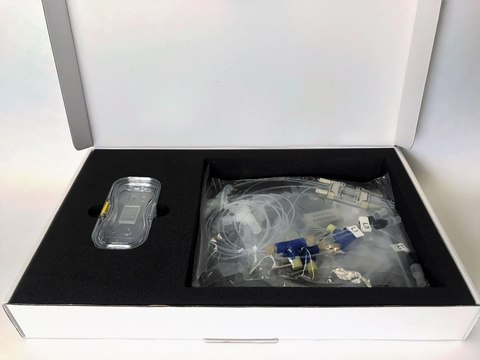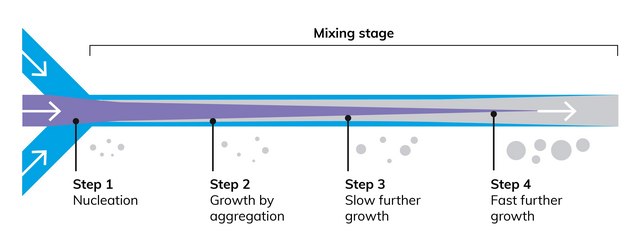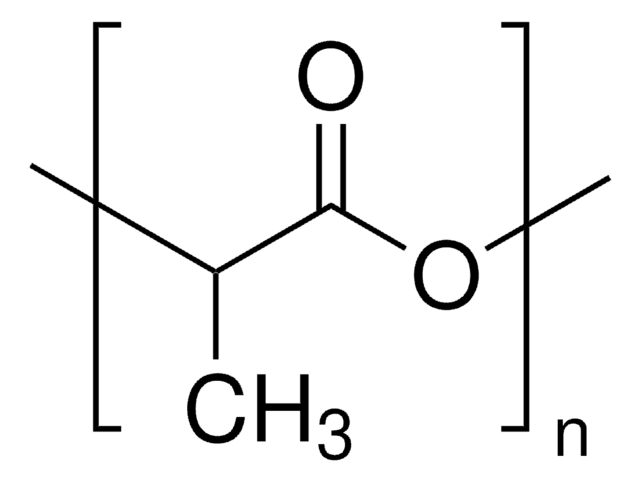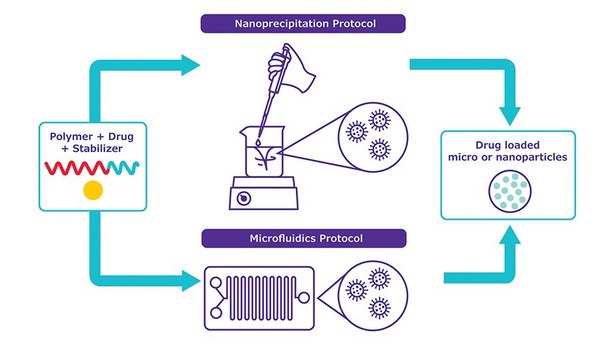推荐产品
一般描述
NanoFabTx™ formulation kits and lipid mixes enable users to encapsulate a wide variety of therapeutic drug molecules for targeted or extended drug delivery without the need for lengthy trial-and-error optimization. NanoFabTx™ kits provide an easy to use toolkit for encapsulating a variety of therapeutics in nanoparticles, microparticles, or liposomes. Drug encapsulated particles synthesized with the NanoFabTx™ kits are suitable for biomedical research applications such as oncology, immuno-oncology, gene delivery and vaccine delivery.
应用
The NanoFabTx™ materials screening kit, for synthesis of polymeric nanoparticles, is a ready-to-use nanoformulation kit for the synthesis of nanoparticles for drug delivery. Poly(lactic-co-glycolic acid) (PLGA), poly(D,L-lactic acid) (PLA) and polycaprolactone (PCL) are biocompatible and biodegradable polymers that have been approved by the FDA for biomedical and pharmaceutical applications. This kit includes properly selected PLGA, PLA, and PCL polymers and stabilizer, allowing for rapid screening of optimal materials for enhanced drug loading and controlled drug release.
特点和优势
- Ready-to-use polymer drug formulation screening kit for non-PEGylated nanoparticles
- Choose from either nanopreciptiation or microfluidics-based protocols
- Create specifically sized, biodegradable, PLGA, PLA, or PCL nanoparticles
- Maximize the encapsulation of hydrophobic drugs
- Four different non-PEGylated polymers are included
制备说明
Comprehensive protocols for nanoparticle synthesis methods are included:
The microfluidics protocol uses NanoFabTx™ device kits (911593), which provide the microfluidics chips, fittings, and tubing required to get started with microfluidics-based synthesis (compatible microfluidics system or syringe pump required).
For more information, please refer to the protocol under the document section of this page.
- A nanoprecipitation protocol to prepare drug-encapsulated nanoparticles in standard laboratory glassware.
- A microfluidics protocol using commercial platforms or syringe pumps.
The microfluidics protocol uses NanoFabTx™ device kits (911593), which provide the microfluidics chips, fittings, and tubing required to get started with microfluidics-based synthesis (compatible microfluidics system or syringe pump required).
For more information, please refer to the protocol under the document section of this page.
法律信息
NANOFABTX is a trademark of Sigma-Aldrich Co. LLC
储存分类代码
11 - Combustible Solids
WGK
WGK 3
法规信息
新产品
S Freiberg et al.
International journal of pharmaceutics, 282(1-2), 1-18 (2004-09-01)
Polymer microspheres can be employed to deliver medication in a rate-controlled and sometimes targeted manner. Medication is released from a microsphere by drug leaching from the polymer or by degradation of the polymer matrix. Since the rate of drug release
C Thomasin et al.
Journal of pharmaceutical sciences, 87(3), 269-275 (1998-04-02)
Phase separation (frequently called coacervation) of poly(lactide) (PLA) and poly(lactide-co-glycolide) (PLGA) is a classical method for drug microencapsulation. Here, attempts have been made to describe this process in the light of thermodynamics. Different PLA/PLGAs were dissolved in either dichloromethane or
Robert F Pagels et al.
Journal of controlled release : official journal of the Controlled Release Society, 219, 519-535 (2015-09-12)
Biologically derived therapeutics, or biologics, are the most rapidly growing segment of the pharmaceutical marketplace. However, there are still unmet needs in improving the delivery of biologics. Injectable polymeric nanoparticles and microparticles capable of releasing proteins and peptides over time
Nazila Kamaly et al.
Chemical Society reviews, 41(7), 2971-3010 (2012-03-06)
Polymeric materials have been used in a range of pharmaceutical and biotechnology products for more than 40 years. These materials have evolved from their earlier use as biodegradable products such as resorbable sutures, orthopaedic implants, macroscale and microscale drug delivery
Byung Kook Lee et al.
Advanced drug delivery reviews, 107, 176-191 (2016-06-06)
Poly(d,l-lactic acid) (PLA) has been widely used for various biomedical applications for its biodegradable, biocompatible, and nontoxic properties. Various methods, such as emulsion, salting out, and precipitation, have been used to make better PLA micro- and nano-particle formulations. They are
商品
NanoFabTX drug delivery formulation kits and lipids mixes for mRNA, nucleic acid, and small molecule delivery in lipid nanoparticles, liposomes and polymeric nanoparticles prepared using Precision NanoSystems microfluidic NanoAssemblr
我们的科学家团队拥有各种研究领域经验,包括生命科学、材料科学、化学合成、色谱、分析及许多其他领域.
联系技术服务部门



